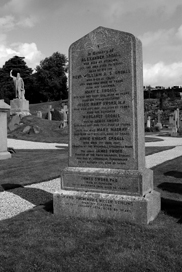Alexander and Annie Croall
Alexander - First Curator of the Smith Institute (now the Stirling Smith Art Gallery and Museum) and Annie - Founder of Stirling Children’s Home
Alexander Croall
First Curator of the Smith Institute (now the Stirling Smith Art Gallery and Museum)
1809 – 1885
Alexander Croall, who was the first Curator of the Smith Institute, was born in Brechin in 1809 and became a teacher. He held posts in and around the Montrose area and also in Ardersier, Inverness-shire, where he met his wife Mary MacKay.
While in Angus, he became involved with the newly opened Museum at Montrose A knowledgeable botanist with a particular enthusiasm for seaweed, he published an innovative, four-volume work on the subject. He was known locally as ‘Roosty Tangle’. Such was his reputation as a botanist, while still a schoolmaster in the tiny hamlet of Guthrie, he was invited by Sir William Hutton, Director of Kew Gardens, to compile a herbarium of the wild flowers around Balmoral for Queen Victoria.
In 1863 he became the first Librarian with Derby Museums and from there he came to Stirling in 1874. A Trust set up by artist Thomas Stuart Smith (whose memorial stone is in the Church of the Holy Rude) had provided funding for a museum, art gallery and reading room in the town. In addition to the work incumbent on the curator of a newly-established Institution, Mr Croall lectured in Botany at the High School of Stirling, and founded the Stirling Field Club, which continues today as the Stirling Field and Archaeological Society. Following failing health, Mr Croall died at the Smith in 1885 and was succeeded by James Sword, the Depute Procurator Fiscal of Stirling, who had provided considerable help and support to Mr Croall for some years. James Sword married Alexander’s second daughter Margaret the following year, and had a family of four.
ANNIE CROALL
Founder of Stirling Children’s Home
1854 – 1927
Annie Croall came to Stirling in 1874, when her father took up his appointment as Curator of the Smith Institute. After her arrival she involved herself in charitable work among local indigent women and children and she was the driving force behind the formation of a Young Women’s Evangelistic Mission. She later concentrated on care of children, and in the 1890s opened the Stirling Children’s Home in Whinwell House, Upper Bridge Street.
Not all the children who found their way to Whinwell were local; many came from other parts of Scotland on the recommendation of a minister or a Medical Officer of Health, or because their parents, for various reasons, were unable to cope. One young newly bereaved father kept in close touch with Annie until he was able to have his children back home. In a letter of 24 August 1910, he told Annie of his intention of remarrying and his wish to collect his children as soon as possible. ‘I am getting a nice motherly woman,’ he assured Annie, ‘very fond of children and an aunt of my landlady.’
No official funding came Annie’s way so parents or local authorities had to make a contribution to the children’s upkeep, and regular fund-raising was carried out in Stirling and the surrounding area.
Under the auspices of the Scottish National Society for the Prevention of Cruelty to Children, many children in care in Scotland were sent abroad to Canada, America or Australia, to what were considered to be caring Christian homes where they would be given the best possible chance. This contentious issue has been well-aired recently, but Annie genuinely felt that ‘Emigration confers upon the children themselves unspeakable blessings,’ regarding it as ‘Such a splendid chance for these wee mites.’
Annie cared for her charges until her death in 1927. The Home, by then under a Board of Trustees, carried on her work until 1980 when legislation deemed institutional care unsuitable. The property was bought by the Aberlour Trust, a Scottish charity involved in childcare, and the Home was closed. In time, the house and land were sold to property developers and a small housing estate was built in the 1990s. The street leading up to the estate is called Whinwell Road, all that now remains of Annie Croall and the Stirling Children’s Home.

